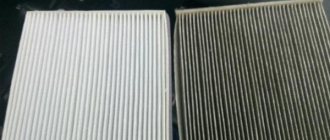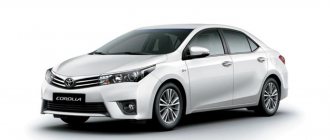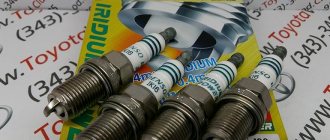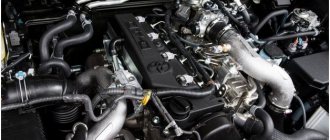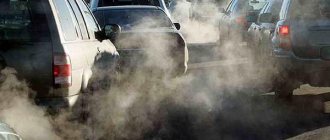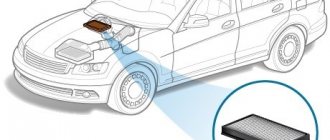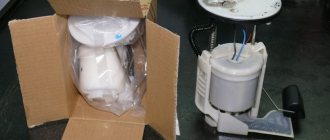Eight years after its debut, the Toyota Corolla was listed in the Guinness Book of Records as the best-selling model. As of 2013, over 35 million cars have been sold.
The most popular Corolla is in the CIS and Russia, including in body variations:
- E120 (2000 - 2007);
- E150 (2008, 2012).
Average level of comfort, safety, noise and vibration insulation, fuel consumption. What the average driver needs when operating a car in megacities.
The equipment is not fussy about maintenance; it will take a couple of minutes to replace the Toyota Corolla cabin filter yourself. Knowledge and experience are not required.
Importance of the filter element
The filter prevents the following from entering the cabin:
- asphalt particles;
- dust;
- pollen;
- road salts;
- dispute;
- pieces of leaves, etc.
The permeability of this element ensures air exchange in the cabin.
Cabin filter replacement frequency
The Toyota Corolla manufacturer indicates the desirability of changing the cabin filter every 20 thousand km. However, this frequency is only sufficient on good roads. In Russian conditions, to maintain normal air exchange in the cabin, it is recommended to install a new element every 10 thousand km.
It should be changed less often if the car is used in the northern regions of the country, where low temperatures last longer and there is a small amount of dust in the air.
In the southern steppe regions, the procedure must be performed more often due to the high rate of clogging. Strong winds are common here, lifting a lot of small debris into the air.
The fact that it is time to replace the dust-retaining element is indicated by a persistent unpleasant odor inside the car, the rapid appearance of a layer of dust on surfaces, and a decrease in the intensity of the air flow. Fogging of windows also indicates the need to perform the procedure.
The importance of having a cabin filter
Drivers with decent experience are often very conservative. In their understanding, a cabin air purification filter is an overkill that also requires additional costs and maintenance efforts. Indeed, being the same consumable as a standard air filter, the cabin equivalent requires periodic replacement, but concern for the health of the people inside the car is not comparable to the efforts spent on replacing it.
The fact is that about 100 cubic meters of air (that’s about 100 thousand liters) passes through the average passenger car over the course of an hour, and even if we assume that the dust concentration does not exceed the maximum permissible concentration (0.5 mg/cubic m), then in 120 minutes The filter deposits approximately a gram of suspended particles ranging in size from 2.5 micrometers. It is microscopic dust that poses the greatest danger to humans (a fraction up to 10 microns in size easily penetrates the respiratory tract, and even smaller particles penetrate the lungs). Considering that on country dirt roads, and even on busy city highways, the concentration of pollutants many times exceeds the maximum permissible dosages, the presence of a cabin filter becomes a prerequisite for creating the most comfortable and safe microclimate for health.
Conventional dust filter elements successfully cope with the task of retaining up to 90% of suspended particles of various sizes, usually invisible to the naked eye. Carbon cabin filters can also adsorb many volatile substances, preventing unpleasant odors and carbon monoxide from entering the cabin.
Note that the Toyota Corolla 120 cabin filter can be made completely impermeable to any airborne substances, but in this case its ability to pass air itself will also suffer, so designers are forced to maintain an optimal balance between these two most important characteristics of the filter material.
Criterias of choice
The filter must be the correct size for the car's socket. Dimensions may vary slightly depending on the year of manufacture and manufacturer. If a parameter mismatch is detected, the element cannot be installed. Standard options are suitable for Toyota Corolla, marked with article number 87139-YZZ07. Coal models mounted on this vehicle are designated No. 88568-52010.
Pros of a carbon filter
Carbon models have a layer of activated carbon. It blocks not only dust particles, but also vapors:
- sulfur dioxide;
- benzene;
- ozone;
- carbon monoxide, etc.
The carbon version is capable of trapping many harmful compounds that make up exhaust gases, as well as trapping unpleasant odors. It is believed that pathogenic microorganisms cannot multiply in it.
Why do most car owners prefer carbon filters?
Structurally, the cabin filter can consist of several layers, but in the case of the carbon version, it includes activated carbon, which is capable of absorbing chemical compounds at the molecular level. Thus, you protect yourself from any harmful substances present in exhaust gases, which is important in many cases (when driving in traffic jams, in tunnels, near polluted industrial zones, livestock farms and other similar places). Advantages of using carbon filter elements:
- when driving in congested conditions, you can use a fan or car air conditioner without any problems (there is no need to turn on the recirculation mode);
- an uncontaminated carbon filter helps reduce glass fogging;
- the level of air purification increases to 95-98%;
- the interior is completely protected from the penetration of external odors and volatile chemicals harmful to health.
Although the cost of a product with a layer of activated carbon is approximately twice as high as its conventional anti-dust counterpart (in some cases the difference can be significantly greater), when replacing a Toyota Corolla cabin filter, many car enthusiasts prefer a more expensive but effective option.
Step-by-step instructions for replacing the cabin filter on a Toyota Corolla
The process of replacing the cabin filter on a Toyota Corolla has some peculiarities. You should remove all items stored in the glove compartment. If you need to change the filter element in winter, it is recommended to warm up the interior, because After freezing, plastic becomes brittle and can break during manipulation.
The glove compartment should be opened and pressed on its sides to release the stops. The cover is removed from the grooves on the lower mount. This will allow you to access the panel. It is secured with latches, so it is easy to remove.
Then you need to carefully remove the used element so that the debris that has accumulated on it does not fall onto the furnace fan. Be sure to compare the old and new elements. Their dimensions must match.
After this, you need to clean the air duct of dust and seeds that have fallen inside. You can use a soft brush. A new element is inserted into the socket. Then, carefully, so as not to damage the latches, mount the protective panel back. Only after this can the glove compartment be installed.
Replacing the filter yourself
The lower loop of the stop is attached here.
If you have “correctly growing” hands, replacing the cabin filtration element of a Toyota Corolla is not difficult at all. Before you change the cabin filter on your Corolla 150 yourself, empty the glove box.
Algorithm for replacing the cabin absorber:
- Empty the glove compartment;
- If replacing in the cold season, it is better to pre-warm the car, since cold plastic is fragile and therefore often cracks when pressed;
- To dismantle the glove compartment, carefully move the side walls and open the fixing elements of the drawer pull-out;
- Remove the glove compartment from the hook-shaped fasteners at the bottom of the glove compartment;
- Behind it is a cover covering the cabin filter. To remove the part, simply press down on the side clips attached to the body
- Take out the anti-dust element. Avoid getting debris into the air duct and heating fan, perform the manipulation very carefully, without pulling the filter with force;
- Insert a new filter.
Attach the support leg to the glove box
After completing the installation of the new absorber, fasten the filter cover, and then assemble the glove box back.
How often should I replace it?
According to the regulations for the ninth generation, replacing the Toyota Corolla cabin filter must be performed at even-numbered maintenance, that is, every 20 thousand kilometers.
In most modern cars, this periodicity is more frequent, and the filter is not always able to work adequately for such a long time.
Therefore, in most cases, it makes sense to talk about the wisdom of replacing the cabin filter on Corollas every 10,000 km, with the only exception being the northern regions - their winters are long, so the rate of filter contamination with dust and organic matter is noticeably lower.
The most severe operating conditions are in non-chernozem regions: in the summer, the filter actively collects pollen, fluff, road dust and soot microparticles from the exhaust; in the fall, wet leaves are added to this, which quickly lead to the development of rot on the filter curtain.

